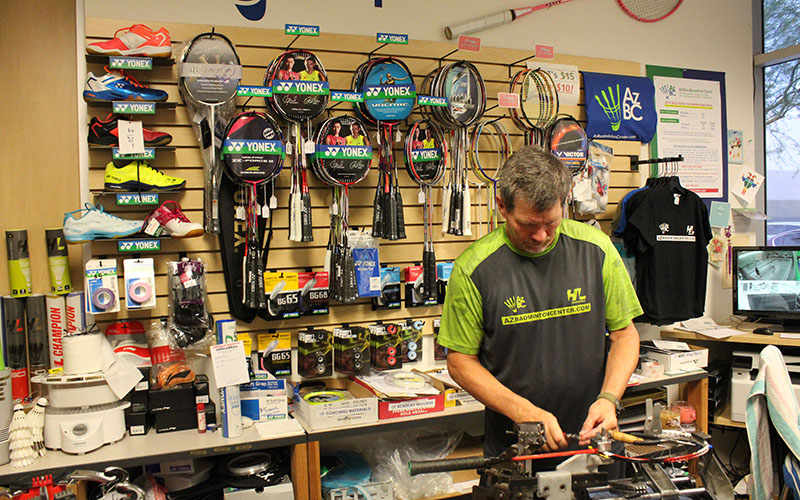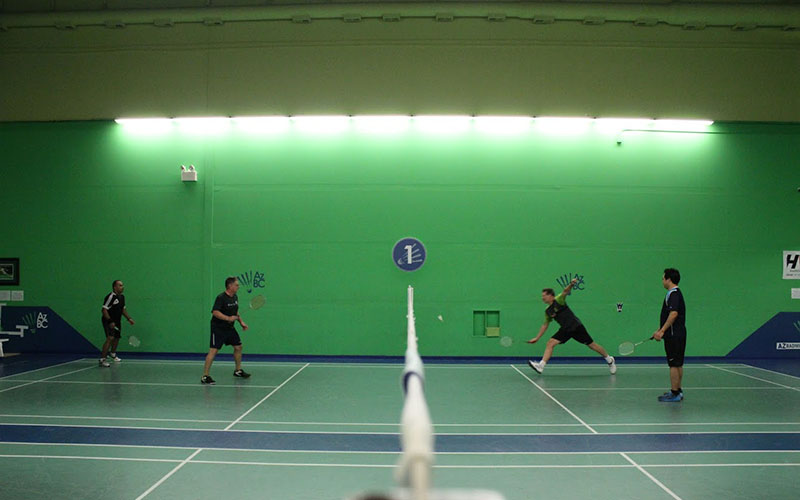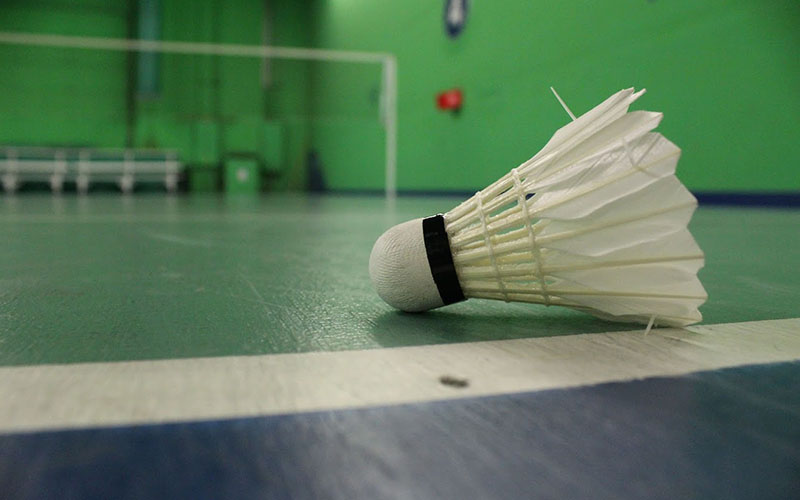- Slug: Sports-Mesa Badminton,1820
- Photos available (thumbnails, captions below)
By MICHAEL BOYLAN
Cronkite News
MESA – When people hear there is badminton being played in the Valley, Guy Chadwick expects one of two reactions.
“We have two kinds of surprise,” Chadwick said. “We have the surprise, ‘Oh, there’s actually badminton here in Arizona?’ because they’re people that know about it, real badminton, in other places.
“And then we have, of course, the people that don’t know about badminton and think of it only as a backyard sport.”
Either way, Chadwick, club director and owner of the Arizona Badminton Center in Mesa, is happy to make more people aware of badminton’s presence in Arizona.
“We’ve been here almost five years now,” Chadwick said. “Every year we grow more and more as the word gets out that we actually have a badminton facility.”
Chadwick said he first encountered the sport when he was a student at Chaparral High School in Scottsdale during the 1970s. He played what some would consider more established sports, like baseball, tennis and soccer.
But once he tried badminton and realized how well he could play, he was hooked.
“I just fell in love with the sport,” Chadwick said. “It became a lifetime thing for me.”
He isn’t alone. According to the Sports and Fitness Industry Association, more than 7 million people participated in badminton in the U.S. last year.
Chadwick’s first experience with the sport led to Arizona State, where he played from 1978 to 1980 and then coached from 1988 to 1993. He won two national championships as a player and as a coach his men’s and women’s and men-women mixed teams won 18.
After coaching at ASU, Chadwick’s dream was to have a permanent, badminton-specific facility in Arizona, a dream he has realized with the Arizona Badminton Center.
“I wanted to improve the experience here in Arizona and so for 25 years we’ve looked for a place to actually call home,” Chadwick said. “You just can’t have a full badminton experience in a borrowed facility.”
Say Diep, who’s played badminton for the last 16 years, said he would play at the temporary spots where Chadwick would set up badminton courts, such as Independence High School in Glendale, before the Mesa center was created.
But once Chadwick opened the facility, Diep jumped at the chance to join.
“This was the first facility that opened, so I was one of the first members to sign up,” Diep said.
Chadwick says the Arizona Badminton Center currently has about 150 members, but he sees many more visitors, who come there to take advantage of a facility created specifically for badminton.
The facility
If badminton was going to thrive in the Valley, Chadwick said that creating a place like the Arizona Badminton Center was critical.
“We need to build the infrastructure for the sport for it to grow and for it to have an understanding in the general community,” Chadwick said.
But it isn’t as simple as putting up nets and putting lines down on a floor. Chadwick said that the details of the facility are what make it work, and that if any part wasn’t up to the standard it needed to be, the whole place would fail.
“You have to have a facility that’s exactly the right dimensions,” Chadwick said.
The center has just under 7,000 square feet of space, according to Chadwick. It allows for four courts with space for people to move around each. Anything bigger or smaller would lead to wasted space and difficulty managing air flow from the air-conditioning system.
In a badminton facility, air has to be moved along the walls, blowing downward along them. If not, air movement can affect the integrity of the game because the flight of a lightweight shuttlecock can be altered by the blowing air.
But that’s not all. Chadwick said his concerns when creating the facility ranged from the flooring to the lighting, to the design of the pro shop.
Even the color of the walls was chosen with the game in mind. A visitor might wonder about Chadwick’s taste – or lack of it – given the brilliant, otherworldly green he selected for the facility’s walls. There’s a reason for Chadwick’s choice.
The shuttlecock stands out against the bright, green color of the walls, allowing players to see the bird as it is zips back and forth over the net at up to 200 mph for elite players.
Chadwick said the attention to detail makes the facility suitable for playing host to tournaments as well as recreational play and is available seven days a week.
The players
While the center is designed to meet the standards of elite players, beginners are welcome, too. Chadwick offers a number of badminton classes for players of all ages and skill levels.
Alex Bimes, who’s been playing badminton and coming to the Arizona Badminton Center for about nine months, said that the club’s welcoming atmosphere for beginners has been one of the best aspects of the club.
“This place is really cool because you can come here, if there’s an open court, anyone can hop on,” Bimes said. “So you kind of get a lot of different skill levels, especially when you’re first starting out.”
Bimes said the possibility of playing with people above one’s own skill level can help new players improve.
“You’ll be with other beginners but also experienced, and I think that kind of elevates your game a lot faster than if you’re just playing with the same people over and over,” Bimes said.
While Chadwick coached champions at ASU and many of them went on to compete in the Olympics, he still finds a lot of enjoyment in helping people who are picking up a racket for the first time.
“I love it when I see new beginners play, and I like helping out the young kids,” Chadwick said. “I love every level of play. I enjoyed coaching Olympians, but I enjoy coaching kids just as much.”
Diep said that a badminton-specific facility helps players of all skill levels improve.
“It facilitates people wanting to get better in the sport,” Diep said.
The schools
Badminton also is played at 64 Valley high schools, according to the Arizona Interscholastic Association’s website.
Chadwick, who runs officiating for high school badminton, said that the high school sport is just as important to the growth of the game as was the creation of the Arizona Badminton Center.
“High school badminton is the backbone of badminton here,” Chadwick said. “It’s growing at the high school level because, as Phoenix grows, more and more districts are adding their schools to play.”
Tim Rosinbum, girls badminton coach at Mountain Ridge High School in Glendale, said he’s seen increased interest in badminton in the six years he’s coached.
“Almost every year, the girls trying out for the sport, that number has grown,” Rosinbum said. “I do think the word is spreading, mostly down to the middle schools, that this is a great sport to participate in.”
However, there are fewer opportunities to play beyond high school than when Chadwick played and coached.
Badminton has been an Olympic sport since 1992, but the NCAA does not sponsor the sport. Chadwick said a lack of NCAA status made it easy for ASU to eliminate the sport after the 1993 season, despite the program’s rich history.
“It sounded big because we were national champions. ‘Oh, we have to cut the the badminton team,’” Chadwick said. “But at the same time, you didn’t have the NCAA or other schools coming in to put pressure on ASU to keep the team. There was no leverage like that.”
Now, badminton is relegated to club status, and Chadwick said the lack of NCAA status limits the sport’s growth more than any other factor.
“I think that’s the single most important thing for badminton, is for it to become an NCAA sport,” Chadwick said. “Then you have parents that are looking for scholarship opportunities for their kids.”
Rosinbum said he’s had former players return and tell him how they’ve continued with the sport through a club or intramural programs offered by their college.
Mackenzie Whitten, a senior at Mountain Ridge and captain of the varsity badminton team, said she’s enjoyed playing the sport over her four years at Mountain Ridge, and would love the opportunity to play for a club team in college.
Whitten also plays softball at Mountain Ridge and expects to play that at the college level. But she plans to continue playing badminton, even if it is only on a club level.
“If there’s a badminton club in the college I go to then, heck yeah, I’m going to join,” Whitten said. “I love the sport, and if I could get a scholarship for it, I’d probably choose this over softball.”
The sport
While the sport may be growing, there are still those who see badminton as a leisure activity to be played in the backyard during the family barbecue.
For people who don’t consider it a serious sport, Chadwick takes a two-pronged approach to convince them otherwise. First, he suggests taking a look at elite players via the Internet.
“You can Google badminton rallies and you’ll see some of the most amazing athletic things that you’ve ever seen in your life,” Chadwick said. “It’s very fast, very physical, very agile, very athletic.”
If that doesn’t convince them, he moves to step two.
“Get them to walk on the court,” Chadwick said. “All it takes is about a minute and and you make them move around on the court a little bit and they realize, ‘Oh, this isn’t so easy.’”
Whitten has tried to recruit people to join the Mountain Ridge team and has heard the badminton-isn’t-a-sport refrain many times. Like Chadwick, Whitten suggests people step on the court before judging.
“It’s a lot harder than people think it is,” Whitten said. “It takes endurance and it takes skill and it takes talent and athleticism, They should come try it themselves before they say it isn’t a sport.”
^__=
Guy Chadwick won 20 national championships as a player and coach of Arizona State’s badminton team, and he still has some of those trophies displayed in the lobby of the Arizona Badminton Center. (Photo by Michael Boylan/Cronkite News)
In the pro shop at the Arizona Badminton Center, Guy Chadwick restrings a racket for Alex Bimes, who referred to Chadwick as, “the godfather of badminton here in Arizona, and really the southwest.” (Photo by Michael Boylan/Cronkite News)
The Arizona Badminton Center has specially placed air-conditioning and lighting to keep them from becoming a hindrance to players. The green walls also help with shuttlecock visibility. (Photo by Michael Boylan/Cronkite News)
While most backyard badminton players would end up using a nylon shuttlecock, the ones used in Olympic play are made with goose feathers. Both are used at the Arizona Badminton Center, though top players say the feathered shuttlecocks play better. (Photo by Michael Boylan/Cronkite News)



